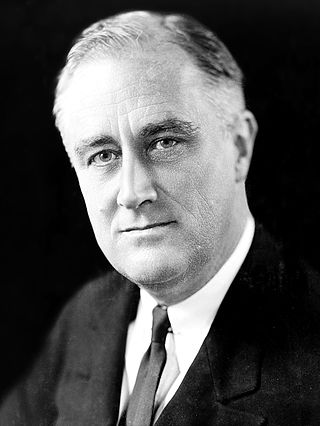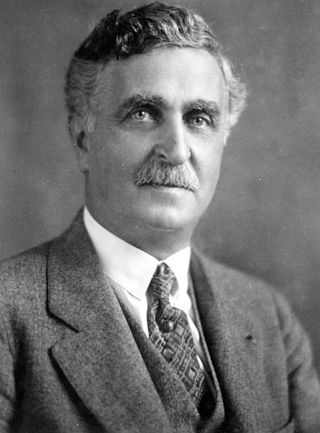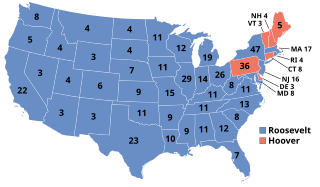
The 1932 United States presidential election was the 37th quadrennial presidential election, held on Tuesday, November 8, 1932. The election took place against the backdrop of the Great Depression. The incumbent Republican President Herbert Hoover was defeated in a landslide by Democrat Franklin D. Roosevelt, the governor of New York and the vice presidential nominee of the 1920 presidential election. Roosevelt was the first Democrat in 80 years to simultaneously win an outright majority of the electoral college and popular vote, a feat last accomplished by Franklin Pierce in 1852, as well as the first Democrat in 56 years to win a majority of the popular vote, which was last done by Samuel J. Tilden in 1876. Roosevelt was the last sitting governor to be elected president until Bill Clinton in 1992. Hoover became the first incumbent president to lose an election to another term since William Howard Taft in 1912, and the last to do so until Gerald Ford lost 44 years later. The election marked the effective end of the Fourth Party System, which had been dominated by Republicans. It was the first time since 1916 that a Democrat was elected president.

The 1932 United States Senate elections coincided with Democrat Franklin D. Roosevelt's landslide victory over incumbent Herbert Hoover in the presidential election. The 32 seats of Class 3 were contested in regular elections, and special elections were held to fill vacancies.
White primaries were primary elections held in the Southern United States in which only white voters were permitted to participate. Statewide white primaries were established by the state Democratic Party units or by state legislatures in South Carolina (1896), Florida (1902), Mississippi and Alabama, Texas (1905), Louisiana and Arkansas (1906), and Georgia (1900). Since winning the Democratic primary in the South almost always meant winning the general election, barring black and other minority voters meant they were in essence disenfranchised. Southern states also passed laws and constitutions with provisions to raise barriers to voter registration, completing disenfranchisement from 1890 to 1908 in all states of the former Confederacy.
Nixon v. Condon, 286 U.S. 73 (1932), was a voting rights case decided by the United States Supreme Court, which found the all-white Democratic Party primary in Texas unconstitutional. This was one of four cases brought to challenge the Texas all-white Democratic Party primary. All challenges were supported by the National Association for the Advancement of Colored People (NAACP). With Smith v. Allwright (1944) the Supreme Court decisively prohibited the white primary.
North American Oil Consolidated v. Burnet, 286 U.S. 417 (1932), was a landmark decision by the United States Supreme Court that established the claim of right doctrine.

The 1932 United States Senate election in South Carolina was held on November 8.

George Otis Smith was an American geologist.

The 1934 United States Senate election in Massachusetts was held on November 6, 1934. Democratic incumbent David I. Walsh was re-elected to a second consecutive term in a landslide over Republican Robert M. Washburn.
United States v. Smith could refer to:

The 1904 United States presidential election in Pennsylvania took place on November 8, 1904 as part of the 1904 United States presidential election. Voters chose 34 representatives, or electors to the Electoral College, who voted for president and vice president.

The 1932 United States elections were held on November 8, during the Great Depression. The presidential election coincided with U.S. Senate, U.S. House, and gubernatorial elections in several states. The election marked the end of the Fourth Party System and the start of the Fifth Party System. The election is widely considered to be a realigning election, and the newly established Democratic New Deal coalition experienced much more success than their predecessors had in the Fourth Party System.
Grovey v. Townsend, 295 U.S. 45 (1935), was a United States Supreme Court decision that held a reformulation of Texas's white primaries system to be constitutional. The case was the third in a series of Court decisions known as the "Texas primary cases".
Terry v. Adams, 345 U.S. 461 (1953), was a United States Supreme Court decision that held white-only pre-primary elections to be unconstitutional. It was the last in a series of court cases addressing the system of white primaries designed to disenfranchise African-American voters in the southern United States.

The 1928 United States presidential election in New Hampshire took place on November 6, 1928, as part of the 1928 United States presidential election which was held throughout all contemporary 48 states. Voters chose four representatives, or electors to the Electoral College, who voted for president and vice president.

The 1928 United States presidential election in Maine took place on November 6, 1928, as part of the 1928 United States presidential election which was held throughout all contemporary forty-eight states. Voters chose six representatives, or electors to the Electoral College, who voted for president and vice president.

The 1928 United States presidential election in Michigan took place on November 6, 1928, as part of the 1928 United States presidential election. Voters chose 15 representatives, or electors, to the Electoral College, who voted for president and vice president.
Fox Film Corp v. Doyal, 286 U.S. 123 (1932), was a United States Supreme Court case in which the Court held that states may tax copyright royalties, as they can patent royalties, because even though copyrights & patents are granted by the federal government, they are still private property subject to taxation.

The 1928 United States presidential election in Colorado took place on November 6, 1928, as part of the 1928 United States presidential election which was held throughout all contemporary forty-eight states. Voters chose six representatives, or electors to the Electoral College, who voted for president and vice president.

The 1924 United States presidential election in Colorado took place on November 4, 1924, as part of the 1924 United States presidential election which was held throughout all contemporary forty-eight states. Voters chose six representatives, or electors to the Electoral College, who voted for president and vice president.












